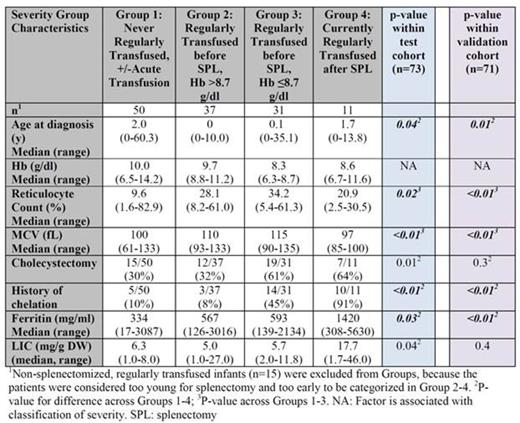Abstract

Background: An international, multicenter registry was established to collect clinical data on patients with PKD, the most common glycolytic defect causing congenital non-spherocytic hemolytic anemia.
Aim: To describe and categorize the phenotypic spectrum of PKD, including the range of lab parameters, management, and complications.
Methods: 144 patients enrolled on the PKD NHS at 23 sites from 3/2014 to 6/2015. For this report, baseline and retrospective data were included. PKD patients were categorized into 4 severity groups (Gp1-Gp4), with increasing severity of the disease: Gp1. Never regularly transfused +/- prior acute transfusions; Gp2. Regular transfusions prior to splenectomy, post-splenectomy baseline hemoglobin (hb) >8.7 g/dl; Gp3. Regular transfusions prior to splenectomy, post-splenectomy baseline hb ≤8.7 g/dl; and Gp4. Post-splenectomy and currently regularly transfused. To reduce the risk of chance associations when dividing the cohort by phenotype, the cohort was divided into a test set (n=73) to define the categories and a subsequent validation set (n=71).
Results: Median age at enrollment was 19.9 years (0.1-70.7) with 47% males. This cohort was 95% Caucasian and 38% Amish. Perinatal complications were frequently reported including preterm birth (33%), perinatal transfusions (35%), and hydrops (10%). Newborn jaundice was common, requiring phototherapy (91%) and/or exchange transfusion (46%). 68% (98/144) had undergone splenectomy at a median age of 3.1 years (0.6-28.1). Common indications for splenectomy included reducing transfusion burden, improving anemia, and enhancing quality of life. The median pre-splenectomy hb was 7.0 g/dl (4.5-12.5). Splenectomy reduced the transfusion burden in 91%. Triggers for hemolysis included: pregnancy (59%), infections (61%), stress (35%), and medications (6%). In the 37% (53/144) who required a cholecystectomy, the median age was 14 years (2.6-60.4) and 35 (66%) occurred post-splenectomy.
In both the test and validation cohorts, increased severity was associated with a younger age at diagnosis (p<0.01) and higher ferritin (p<0.01, Table). More severe patients were more likely to receive iron chelation (p<0.01). Reticulocyte counts and MCV were incrementally higher with increasing severity in the non-regularly transfused Gps (p=0.02).
Gp4 pts required regular transfusions even after splenectomy (11/98). In this group, the median age of splenectomy was 5.0 y (2.1-11.8).
Ferritin was higher in those who had a splenectomy, even after adjusting for transfusion status (p<0.0001). In the Gp1 pts with available iron studies, even in the absence of regular transfusions, the majority had evidence of iron overload; 7/10 (70%) had a liver iron concentration (LIC) >4 mg/g dry weight and 9/11 (82%) had ferritin >500 ng/ml. Chelation was used in 35 patients at a median age of 11.8 years (1-53.7) with a median ferritin 815 ng/ml (182-5630) and median LIC 5.7 mg/g dry weight (1.7-46.0).
Conclusions: This NHS cohort is the largest assembly of PKD patients to date. We defined 4 severity Groups, based on transfusion history, anemia, and splenectomy status. Complications (e.g. iron overload) correlate with disease severity but also occur in milder phenotypes. Based on these findings, regular monitoring of iron status and screening for gallstones should be considered. Transfusion dependence persisted despite splenectomy in 11% of patients. Prospective data from the NHS will provide guidance for monitoring and treatment in this rare anemia.
Grace:Agios: Honoraria, Membership on an entity's Board of Directors or advisory committees, Research Funding. Morton:Agios: Honoraria, Membership on an entity's Board of Directors or advisory committees. Eber:Agios: Honoraria, Membership on an entity's Board of Directors or advisory committees. Yaish:Agios: Membership on an entity's Board of Directors or advisory committees. Nottage:Janssen Pharmaceuticals: Employment. Kuo:Alexion: Honoraria, Membership on an entity's Board of Directors or advisory committees; Novartis Canada: Honoraria, Membership on an entity's Board of Directors or advisory committees. Neufeld:Agios: Honoraria, Membership on an entity's Board of Directors or advisory committees.
Author notes
Asterisk with author names denotes non-ASH members.

This icon denotes a clinically relevant abstract


This feature is available to Subscribers Only
Sign In or Create an Account Close Modal